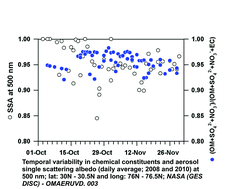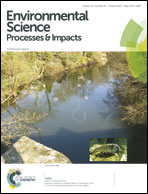Organic aerosols and inorganic species from post-harvest agricultural-waste burning emissions over northern India: impact on mass absorption efficiency of elemental carbon†
Abstract
Atmospheric PM2.5 (particulate matter with aerodynamic diameter of ≤ 2.5 μm), collected from a source region [Patiala: 30.2 °N; 76.3 °E; 250 m above mean sea level] of emissions from post-harvest agricultural-waste (paddy-residue) burning in the Indo-Gangetic Plain (IGP), North India, has been studied for its chemical composition and impact on regional atmospheric radiative forcing. On average, organic aerosol mass accounts for 63% of PM2.5, whereas the contribution of elemental carbon (EC) is ∼3.5%. Sulphate, nitrate and ammonium contribute up to ∼85% of the total water-soluble inorganic species (WSIS), which constitutes ∼23% of PM2.5. The potassium-to-organic carbon ratio from paddy-residue burning emissions (KBB+/OC: 0.05 ± 0.01) is quite similar to that reported from Amazonian and Savanna forest-fires; whereas non-sea-salt-sulphate-to-OC ratio (nss-SO42−/OC: 0.21) and nss-SO42−/EC ratio of 2.6 are significantly higher (by factor of 5 to 8). The mass absorption efficiency of EC (3.8 ± 1.3 m2 g−1) shows significant decrease with a parallel increase in the concentrations of organic aerosols and scattering species (sulphate and nitrate). A cross plot of OC/EC and nss-SO42−/EC ratios show distinct differences for post-harvest burning emissions from paddy-residue as compared to those from fossil-fuel combustion sources in south-east Asia.


 Please wait while we load your content...
Please wait while we load your content...